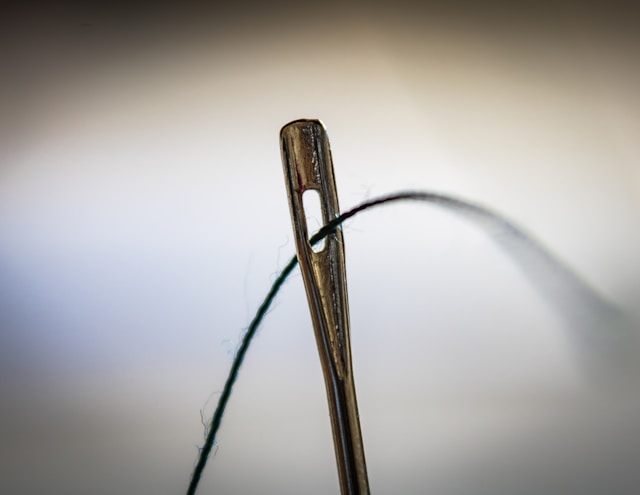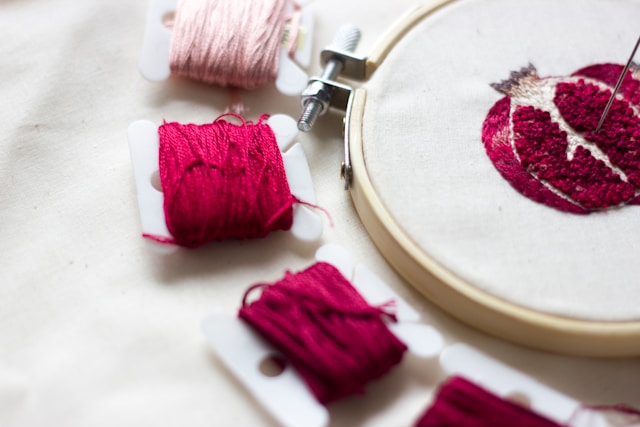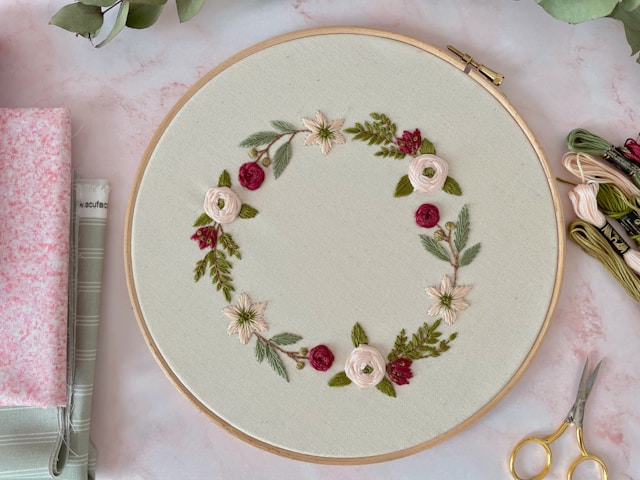The slow stitching movement is about more than just crafting—it’s a way to bring deep presence, patience, and meditation into your creative practice. Unlike fast-paced, production-focused crafting, slow stitching invites you to slow down, savor each stitch, and fully engage with the process rather than rushing toward the result.
Many people turn to slow stitching for its relaxing, therapeutic benefits, but few realize just how deeply it can enhance mindfulness. Whether you’re practicing hand embroidery, visible mending, quilting, or free-form stitching, engaging in slow stitching grounds your nervous system, deepens awareness, and cultivates a sense of inner stillness.
Here are inspiring ways slow stitching helps boost mindfulness, along with a hands-on exercise to help you bring more awareness into your fiber arts practice.

1. Trains Your Brain to Tolerate Stillness
In a world where we’re constantly multitasking—checking notifications, scrolling through social media, and juggling responsibilities—our brains become wired for constant stimulation. This makes true stillness feel uncomfortable.
Slow stitching gradually retrains your brain to sit in stillness without restlessness or the need for distraction. By focusing only on the fabric, the thread, and the movement of your hands, you create a dedicated pause in your day, allowing your nervous system to settle. Over time, this makes it easier to embrace moments of quiet without feeling antsy or uncomfortable.
2. Encourages Deep, Intentional Breathing
Most of us go through our day breathing in short, shallow bursts, which signals stress to the body. Slow stitching naturally slows your breath as you focus on each stitch, but you can take this further by consciously syncing your breathing with your stitching.
- Inhale as you guide the needle through the fabric.
- Exhale as you pull the thread through.
- Pause for a moment before beginning the next stitch.
This mindful breathing technique enhances relaxation, calms the mind, and helps regulate the nervous system.
3. Engages the Hands in a Way That Calms the Mind
Mindfulness is often associated with meditation, but many people struggle to sit still and quiet their thoughts. Slow stitching provides a physical anchor that keeps your hands engaged while allowing your mind to soften.
This gentle, repetitive movement gives the brain a structured focus, similar to mala bead meditation or prayer stitching traditions found in various cultures. Instead of trying to force your thoughts to be quiet, your hands guide your attention back to the present moment, over and over again.
4. Creates a Nonverbal Emotional Processing Space
Emotions don’t always need words. Sometimes, the best way to process emotions is through movement and touch.
Slow stitching allows you to work through emotions without forcing yourself to articulate them. The slow, steady action of the needle moving through fabric provides a safe, nonverbal space to release tension, frustration, grief, or stress. Many people find that stitching while listening to music, sitting in silence, or reflecting on personal thoughts helps them move through emotions with a sense of ease rather than resistance.

5. Strengthens the Connection Between Hand, Eye, and Mind
Most of our daily activities are disconnected from the body—we type on keyboards, swipe on screens, and move through life without full awareness of our movements. Slow stitching restores the connection between your hands, your vision, and your awareness.
✔ Your hands feel the texture of the fabric and thread, noticing tension and subtle sensations.
✔ Your eyes follow the needle’s path, tracking each stitch with curiosity and patience.
✔ Your mind stays engaged with the process, bringing attention back to the present each time it drifts.
This heightened hand-eye-mind connection not only enhances mindfulness but also improves fine motor skills and hand dexterity, making it a valuable lifelong practice.
6. Offers a Sensory Meditation Experience
Traditional meditation often focuses on the breath, but slow stitching offers a sensory-based form of meditation that engages touch, sight, and sound.
- Touch – The softness of fabric, the tension of thread, the slight resistance as the needle moves through layers.
- Sight – Watching the patterns emerge, seeing the colors come together, observing the slight imperfections that make the piece unique.
- Sound – The subtle rustling of fabric, the quiet pull of thread, the rhythmic repetition of movement.
By fully engaging the senses, slow stitching becomes a tactile meditation practice that anchors you in the moment.
7. Helps Break Perfectionist Thinking Patterns
One of the biggest barriers to mindfulness is the fear of doing something “wrong.” Many creative people struggle with perfectionism, which makes it difficult to truly relax into the process of making.
Slow stitching encourages imperfection, irregularity, and freeform creativity. Unlike structured patterns or machine sewing, it embraces organic, unplanned stitching, reinforcing the idea that beauty can exist in imperfection. This teaches self-acceptance, patience, and trust in the process, rather than a fixation on perfect results.
8. Creates a Personal Ritual That Signals Rest
The body thrives on ritual and repetition—having specific activities that signal it’s time to slow down, breathe, and enter a more peaceful state.
Engaging in slow stitching at the same time each day, such as in the evening before bed, can train your body and mind to associate it with relaxation. Just as drinking tea or lighting a candle can act as a cue to unwind, pulling out your stitching project can become a signal that you’re entering a state of rest and mindfulness.
9. Gives Time a Physical Form
In our fast-paced world, time often feels like it’s slipping away, lost in emails, notifications, and endless to-do lists. Slow stitching makes time tangible.
Each stitch marks a moment of presence, a physical representation of time spent mindfully. When you look back on a finished piece, you can see the hours, the emotions, and the memories woven into it. Unlike fleeting distractions, this is time you can touch, hold, and reflect on—reminding you that mindfulness is not something to chase, but something to cultivate in every stitch.

Slow Stitching Exercise: The One-Stitch Meditation
If you want to experience slow stitching as a mindfulness tool, try this simple exercise:
- Choose a single color of thread or embroidery floss that represents how you want to feel—calm, grounded, joyful, peaceful.
- Take a deep breath in, then slowly insert your needle into the fabric.
- As you pull the needle through, exhale fully, releasing tension from your shoulders.
- Repeat this process, focusing only on the rhythm of breath and stitch.
- If your mind drifts, simply bring it back to the motion of the needle and the texture of the fabric.
Even just five minutes of mindful stitching can help reset your nervous system, bringing a greater sense of calm and clarity.
Next Steps: Using Slow Stitching as a Mindfulness Practice
Slow stitching is more than a craft—it’s a way to cultivate presence, patience, and peace in your daily life.
✔ Set aside time for slow stitching as a mindfulness ritual. Create without rushing, savoring each stitch.
✔ Experiment with freeform stitching. Let go of patterns and stitch intuitively to encourage creative mindfulness.
✔ Use stitching as a form of meditation. Focus on breath, rhythm, and texture while you work.
If you’re looking for ways to deepen your connection to slow, mindful making, the Craft to Heal year-long workshop series explores different ways to use fiber arts as a tool for self-care, emotional healing, and creativity.
🧶 Want to learn more? Click here to join Craft to Heal.
